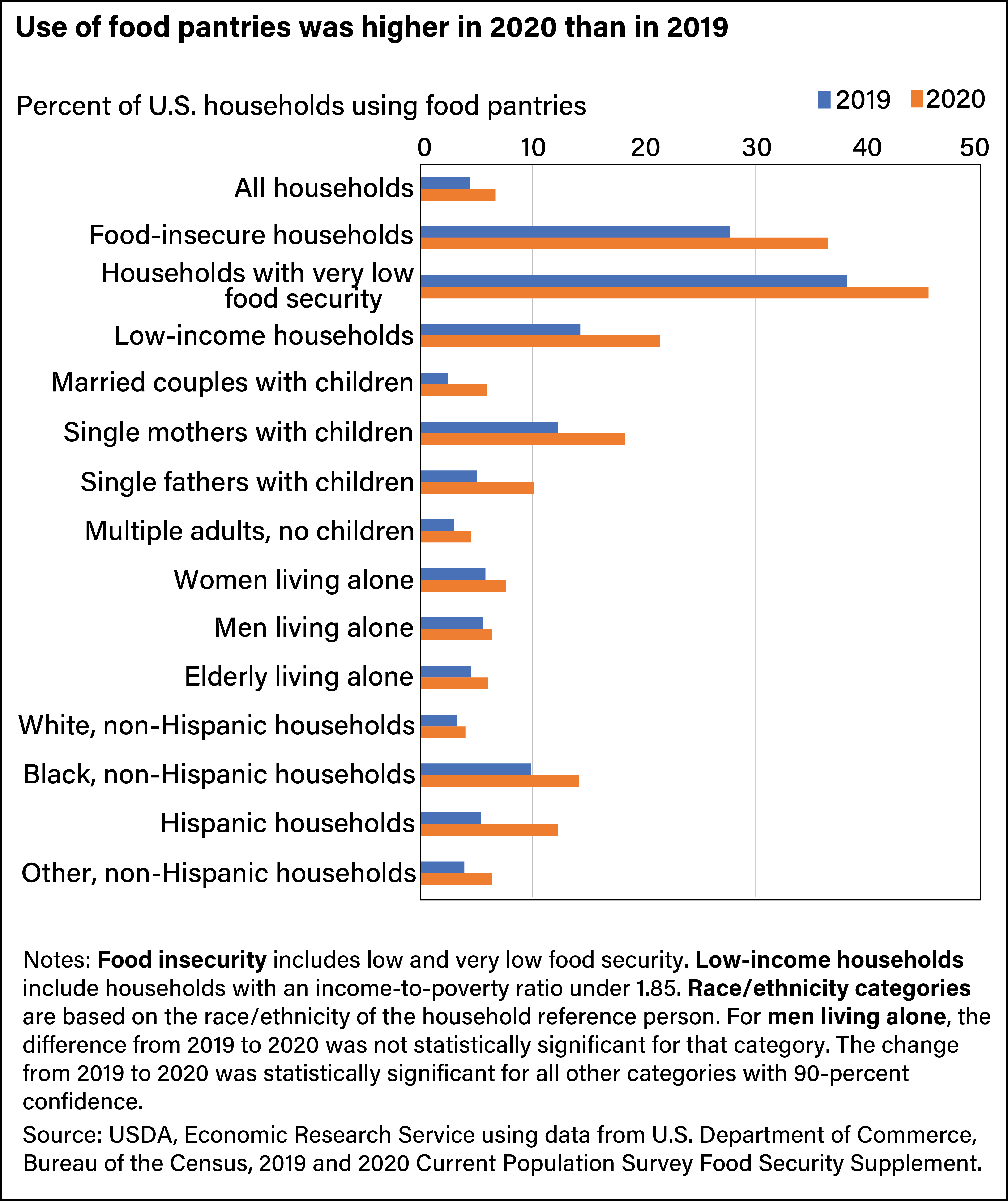
Food Pantry Use Increased in 2020 for Most Types of U.S. Households
- by Alisha Coleman-Jensen and Matthew P. Rabbitt
- 11/8/2021
Households struggling to put enough food on the table may participate in Federal nutrition assistance programs and community food assistance programs, such as food pantries, to help meet their food needs. Food pantries typically provide free food for clients to take home and prepare. Food pantries are often affiliated with faith-based organizations and rely heavily on volunteers. Some households may turn to food pantries only in times of emergency, while other households may use food pantries on a more regular basis.
Data from the Current Population Survey Food Security Supplement sponsored by the USDA, Economic Research Service (ERS) shows that use of food pantries increased from 2019 to 2020. In 2020, 6.7 percent of all U.S. households reported using a food pantry, an increase from 4.4 percent in 2019. Comparable data on food-pantry use is available going back to 2001, and since then the previously reported high for use of food pantries was in 2014, when 5.5 percent of U.S. households used a food pantry. Among food-insecure households, 36.5 percent reported using a food pantry. USDA defines households as food insecure if they had difficulty providing enough food for all members at some time in the past year because there wasn’t enough money for food. Among households with very low food security, 45.5 percent reported using a food pantry. USDA characterizes very low food security—the more severe range of food insecurity—as reduced food intake and disruptions in normal eating patterns of one or more household members during the year. Across all types of households, including various racial and ethnic groups, food pantry use was up in 2020 from 2019. Nearly all annual increases in food pantry use in 2020 shown in the figure below were statistically significant; men living alone is the only group for which the change in food pantry use was not statistically significant.
While food pantry use increased in 2020, the prevalence of food insecurity in the United States was unchanged from 2019 at 10.5 percent. Food insecurity may have been unchanged because of the availability of increased Federal nutrition and other assistance in response to the Coronavirus (COVID-19) pandemic, which also increased resources provided to food banks and food pantries. USDA provides resources to food pantries through The Emergency Food Assistance Program (TEFAP). In fiscal year 2020, TEFAP supplied 2.2 billion pounds of USDA Foods (including fruits and vegetables, eggs, meat, poultry, fish, nuts, milk and cheese, and rice, cereal, and pasta) to community emergency food providers, up from 1.7 billion pounds supplied in fiscal year 2019. Also, in fiscal year 2020, USDA’s Farmers to Families Food Box Program distributed 92 million food boxes of produce, dairy, and meat products to food banks and other charitable organizations nationwide.
This article is drawn from:
- Coleman-Jensen, A., Rabbitt, M.P., Gregory, C.A. & Singh, A. (2021). Statistical Supplement to Household Food Security in the United States in 2020. U.S. Department of Agriculture, Economic Research Service. AP-091.
- Toossi, S., Jones, J.W. & Hodges, L. (2021). The Food and Nutrition Assistance Landscape: Fiscal Year 2020 Annual Report. U.S. Department of Agriculture, Economic Research Service. EIB-227.
You may also like:
- Coleman-Jensen, A. (2018, November 5). Food Pantries Provide Emergency Food to More Than One-Quarter of Food-Insecure Households. Amber Waves, U.S. Department of Agriculture, Economic Research Service.
- Coleman-Jensen, A., Rabbitt, M.P., Gregory, C.A. & Singh, A. (2021). Household Food Security in the United States in 2020. U.S. Department of Agriculture, Economic Research Service. ERR-298.


